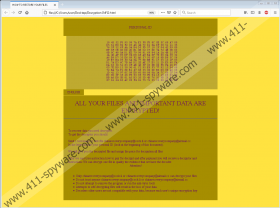CC1H Ransomware Removal Guide
CC1H Ransomware is a dangerous file-encrypting application. Like other similar threats, it enciphers private victims’ data and displays a ransom note afterward. As you can imagine, the note contains information like how to contact the malware’s creators and how to get your data decrypted. Naturally, hackers ought to say that they will help only those who pay a ransom. However, our specialists warn that there are no guarantees that users will receive what they pay for, which means they might be scammed. This is why we advise not to pay the ransom and erase CC1H Ransomware. If you want to learn more about this ransomware application or how to erase it, we invite you to read our full report. A bit below it, you can find our deletion instructions that explain how to remove CC1H Ransomware manually.
One of the most important things to know about threats like CC1H Ransomware is that they can be spread via files and links disguised to make them appear harmless. Hackers can also use various ways to distribute malicious launchers, for example, they may send them via spam emails, file-sharing websites, or pop-ups and advertisements. Thus, users have to be extra careful when they receive files and links or download data from unknown or unexpected sources. It is always a good idea to scan a file with a reliable antimalware tool if you do not know whether it is harmful or not. Make sure that you do so before opening the file in question to avoid infecting your system unknowingly. We also recommend ensuring that your operating system and other software is up to date. Besides outdated software, specialists recommend removing weaknesses like unsecured Remote Desktop Protocol connections and weak passwords. That is because the mentioned vulnerabilities might help hackers gain access to your device and drop malware on it.
If CC1H Ransomware enters a system, it may create a copy of its launcher in the %APPDATA% directory and a Registry entry in the HKCU\Software\Microsoft\Windows\CurrentVersion\RunOnce location. Afterward, the malicious application should start encrypting photos, videos, documents, and other types of files that could be irreplaceable and valuable to you. Once encrypted, a file should receive the .CC1H extension, for example, receipt.pdf.CC1H. Users should be unable to open such files because the only way to do so is to decrypt them first. The malware ought to drop a ransom note called Decryption INFO.html on a victim’s Desktop. According to the note, users can get the decryption tools needed for the decryption process, but they need to contact the threat’s creators first and then pay a ransom. We cannot tell what the sum could be as we have not contacted CC1H Ransomware’s developers ourselves. Plus, they could ask for different amounts of money from each victim. In any case, we do not recognize contacting them or paying the ransom because there is a possibility that hackers might not hold on to their end of the deal. In which case, you could lose the money you send hackers for nothing.
Lastly, we advise users to get rid of the ransomware because it looks like the malware might be able to restart with the operating system. If it does, there is a risk that it could start encrypting new files. To prevent this, we recommend erasing CC1H Ransomware. If you want to deal with it manually, you could try completing the deletion instructions located below this paragraph. We cannot guarantee that they will work in every case. Also, the process might still seem difficult if you are an inexperienced user. In which case, it would be easier to pick a reliable antimalware tool and let it eliminate CC1H Ransomware for you.
Get rid of CC1H Ransomware
- Tap Ctrl+Alt+Delete.
- Pick Task Manager.
- Select the Processes tab.
- Look for a process associated with the malware.
- Select the process and click End Task.
- Leave Task Manager.
- Tap Win+E.
- Go to these locations:
%TEMP%
%USERPROFILE%\Downloads
%USERPROFILE%\Desktop - Find the malicious file opened before the system got infected, right-click it, and select Delete.
- Search for a file named Decryption INFO.html on your Desktop, right-click it, and select Delete.
- Check this location: %APPDATA%
- Find the malware’s created .exe file, right-click it, and choose Delete.
- Close File Explorer.
- Tap Win+R.
- Type Regedit and click Enter.
- Go to: HKCU\Software\Microsoft\Windows\CurrentVersion\RunOnce
- Identify the malware’s created value name, e.g., CertificatesCheck, right-click this value name, and press Delete.
- Close Registry Editor.
- Empty Recycle Bin.
- Restart the computer.
CC1H Ransomware Screenshots:


